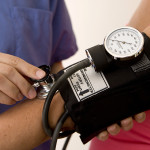By Bonnie Jenkins, Advanced Natural Wellness
If you’ve got high blood pressure, you’ve no doubt been told to stay away from salt. But even if you never touch the salt shaker, you may still be getting more sodium than you think. Recent reports reveal high levels of sodium in some unexpected places, including sweet snacks, breakfast foods, low-fat products, and restaurant meals. In fact, 77 percent of the sodium we get comes from these sources.
Even if you don’t suffer from hypertension, you probably get considerably more sodium than the recommended 2,300 mg. – which is about one teaspoon of salt each day. And that has led the Centers for Disease Control and Prevention to recommend that 70 percent of all adults follow a low-sodium diet.
Beyond Blood Pressure
New research suggests that reducing your sodium intake may also do more than lower your blood pressure readings. It may actually improve the health of your blood vessels. These findings, which were published in the American Journal of Clinical Nutrition, show that even short-term adherence to a low-salt diet significantly improves a blood vessel’s ability to relax.
The researchers recruited 29 overweight and obese volunteers, with an average age of 53 and normal blood pressure levels. The participants were randomly assigned to follow either a low-salt diet or their normal diet for two weeks. After this, the participants switched over to the other diet for two more weeks. Both diets contained similar levels of potassium and saturated fat. By the end of four weeks, the researchers found that the low-salt diet not only lowered the participant’s blood pressure, it also gave their blood vessels much greater flexibility.
MD Exposes the Hidden Danger to Your Eyes

When your eyesight starts to fail, it's a real problem. Suddenly you can't go to the grocery store... you can't get to the doctor if you have an emergency... you can't meet your friends for dinner…
Your "regular" doctor doesn't have time to keep up with the latest research. And the same goes for eye doctors. They go to school to learn how to fit you for glasses and contacts, but have no way of preventing the damage and loss of eyesight that threatens your freedom and independence.
Let me show you something that explains a LOT about how your eyes work.
In my FREE Special Report, I'll show you a HUGE, untapped resource for your eyes that safely and naturally restores clear, effortless eyesight.
Click here to get started...
Surprising Sodium Sources
Just because something doesn’t taste salty, don’t think it automatically has a low sodium content. The Consumer’s Union, a nonprofit group that rates everything from cars to blenders, recently analyzed 37 brands of supermarket food. They found surprisingly high levels of sodium in foods you wouldn’t expect to be salty. Four strands of Twizzlers black licorice, for example, turns out to contain 200 mg. of sodium. And Prego “Heart Smart” pasta sauce has 430 mg. of sodium lurking in each one-half cup serving.
The advocacy group found surprising sources of sodium in restaurant food, too. If you’re looking to curb your sodium intake, you might want to avoid the fajita chicken quesadilla at a popular Tex-Mex restaurant. If you do indulge, you’ll be getting a whopping 5,300 mg. of sodium – more than twice the amount you should be eating for the entire day! Opt instead for grilled salmon at just 420 mg.
How can you ferret out the amount of sodium in your favorite dishes? Most national chains post their nutritional information on their website. So log on and plan your meal before you go.
Avoid Sneaky Salt
If you’re worried about your blood pressure, you’re probably already following some of the recommendations from the American Heart Association. Take the salt shaker off the table and don’t salt your food until after you taste it. Snack on fresh fruits and raw veggies instead of chips and pretzels. Try adding fresh lemon juice to fish and vegetables instead of salt.
But what about the hidden salt you don’t know about? Shake out surreptitious sodium with these tips:
Are You Suffering From...
- Love handles and a pot belly
- Romance that isn't what it used to
- Forgetfulness and inattention
- Low (or no) strength and endurance
- A sex drive that's shifted into neutral...or worse
If so...you may have Mature Male Burnout. Click here to discover more about this unique condition and what you can do about it.
- Choose fresh vegetables instead of canned.
- If canned is your only option, rinse vegetables, beans, and shellfish before using.
- Avoid fish canned in oil or brine. Look for water-packed instead.
- Steer clear of fish that is pre-breaded, pre-fried, or smoked.
- Look for specially marked “low-sodium” ham, bacon, corned beef, lunch meat, and hot dogs.
- Check frozen entrées to make sure they contain less than 700 mg. of sodium per serving.
- Use low-sodium bouillon, broths, and soups.
- Don’t use seasoned salts, meat tenderizers, or MSG.
- Limit the amount of ketchup, mayonnaise, prepared sauces, and salad dressings you use, as they’re almost always high in sodium.
- When eating out, tell your server you’re on a sodium-restricted diet and ask that your meal be prepared without salt.
- When you order, be specific about what you want and how you want it prepared.
Can avoiding hidden sodium really make a difference to your health? Say you plan on having a frozen chicken pot pie for dinner. It’s got 840 mg. of sodium before you ever pick up the salt shaker. If you chose a boneless, skinless chicken breast seasoned with herbs and spices, you’d get a mere 104 mg. That’s a difference of 736 mg. of sodium that you really don’t need.
So, start checking nutrition labels on the foods you buy. You may be amazed at what you see. Then make a conscious choice for lower sodium options.
One Last Thing …
Reducing your sodium intake by replacing the salt in your shaker with a salt substitute may be a good move for your heart. At least that’s what Chinese researchers reported recently in the journal Hypertension Research.
The scientists recruited 600 high-risk people with average blood pressure readings of 150 over 91 mmHg. The participants were randomly assigned to use either regular table salt or a salt substitute made from a combination of salt, potassium, and magnesium. After one year, those using the substitute saw significant drops in their systolic blood pressure. Plus, researchers discovered that many of these participants also had much less arterial stiffness.
If you want to try a salt substitute, you have plenty of options to choose from. Try several to find one that you like. Just be aware, however, that you can also overdo salt substitutes, so sprinkle in moderation.
Research Brief …
Now that Memorial Day has come and gone, many of us will be looking for any excuse to fire up the grill. But cooking that steak until it’s well done could be harmful to your health. A new study finds people who eat meat cooked at high temperatures to the point of burning and charring could be at an increased risk of developing pancreatic cancer.
The link was associated with people who consumed well-done and very well-done meats cooked by frying, grilling, or barbecuing. People who prefer their meat cooked this way were almost 60 percent more likely to get pancreatic cancer than those who ate their steak less well done or those who didn’t eat steak at all. The reason? These cooking methods form carcinogens, which do not form when meat is baked or stewed.
If you’ve just got to have that grilled “taste of summer” flavor, consider turning down the heat or cutting off burned portions when it’s finished. You can also reduce the precursors of cancer-causing compounds by microwaving the meat for a few minutes and pouring off the juices before cooking it on the grill.
For even more protection, take 400 IU of supplemental vitamin E daily. Studies show that people with high blood levels of this important antioxidant have extra protection against pancreatic cancer. It’s so effective that the National Cancer Institute found it even protects smokers against this type of cancer. Look for a vitamin E supplement that is natural (listed on the ingredient panel as d-alpha tocopherol), since natural vitamin E is twice as bioavailable as the synthetic form.
References:
Dickinson KM, et al. “Effects of a low-salt diet on flow-mediated dilatation in humans.” American Journal of Clinical Nutrition. 2009 89: 485-490.
“Eating Charred, Well-done Meat May Increase Pancreatic Cancer Risk.” American Association for Cancer Research 100th Annual Meeting. April 2009.
“Most Americans Should Consume Less Sodium.” CDC. Available at www.cdc.gov/Features/Sodium/
Stolzenberg-Solomon RZ, et al. “Vitamin E intake, alpha-tocopherol status, and pancreatic cancer in a cohort of male smokers.” American Journal of Clinical Nutrition. 2009;89:584-591






